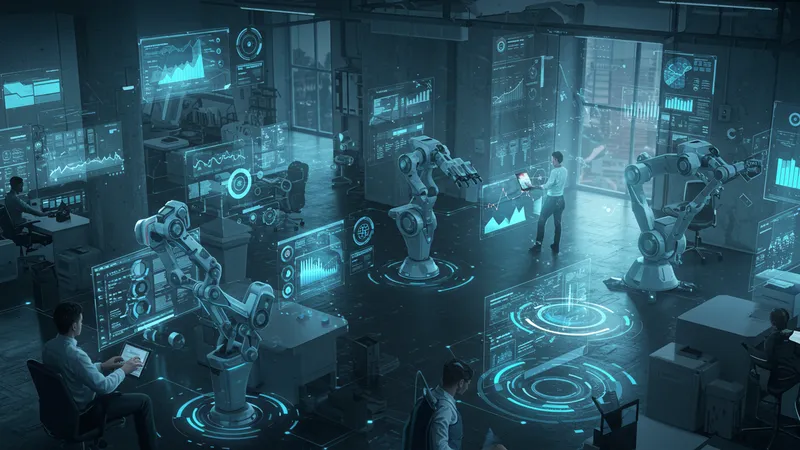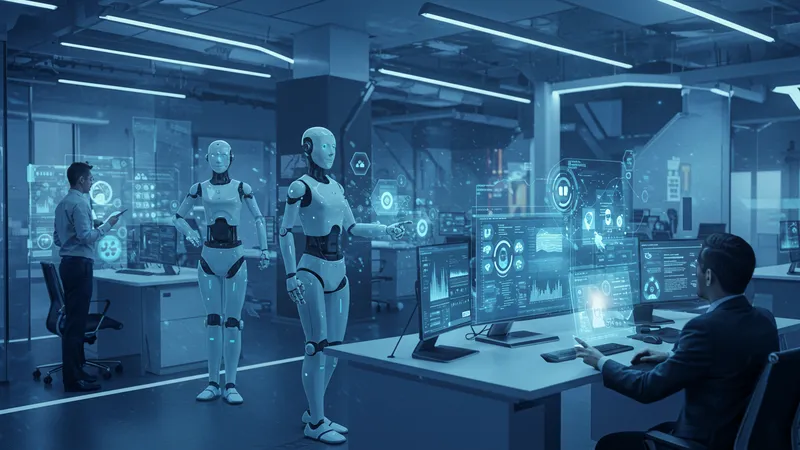

Did you know that some businesses have doubled their productivity overnight using the latest automation tools? Yes, the realm of automation is transforming workflows faster than you can imagine.
In today's world, efficiency isn't just a competitive edge—it's a necessity for survival. Find out why mastering these tools is more crucial than ever in 2023.

Automation tools today aren't just about replacing human tasks—they're revolutionizing the way we think about work. Up until now, businesses that employed these tools found out they could do much more with much less. But here’s where it gets exciting: the impact is not limited to efficiency. Companies are seeing a complete cultural shift as employees invest more time in strategic thinking rather than mundane tasks. But that’s not even the wildest part…
Imagine identifying a hidden opportunity that could not only save time but also money, and insert a level of predictability and control previously unheard of in business operations. The secret lies in harnessing these automation tools to their fullest potential. With the right approach, some companies have even cut their operational time in half while boosting customer satisfaction. What happens next shocked even the experts…
Task automation sounds like tech jargon, but its effects are very much tangible. One unexpected detail? Companies utilizing sophisticated automation tools have reported a staggering 70% reduction in error rates. This doesn’t just boost productivity—it could redefine error management in its entirety. But there's one more twist…

Many employees initially feared they’d be replaced by automation, but the opposite happened. A significant number of staff began focusing on creative and strategic goals, in part because automation removed the monotony of repetitive tasks. This shift in focus is encouraging a generation of workers to innovate further. What you read next might change how you see this forever.
The democratization of powerful software means smaller businesses, too, can enjoy the same efficiency as industry giants. Tools like Monday and Zapier integrate seamlessly even for businesses with lean teams. Insider tips note that redefining roles and leveraging automation tools allow employees to work smarter rather than harder. But we’re just getting started…
It’s not just about efficiency; automation is proving to be a morale booster. Allowing employees to pursue passion projects without sacrificing their day-to-day responsibilities is a win for creativity. The new workplace dynamic nurtures an innovative spirit, showing how even seemingly small automation can have a profound impact. The unexpected results are yet to unfold.
Integration is a buzzword, but here’s where it changes: integrated solutions have allowed teams to communicate in ways that are becoming invaluable. The transformation means a client’s urgent requirement can direct the entire workflow simultaneously, elevating and refining customer interactions at every level. But the real kicker is…

Large-scale implementations show astonishing adaptability, with teams noted for reaching consensus faster due to transparent process flows. The upside is not merely increased efficiency. There’s an unsung advantage—enhanced creativity spurred by clearer collaborative landscapes.
Recent surveys cite a 65% increase in creative solutions for businesses that adopted these integrated tools, soon replacing outdated structures. Like gears in a well-oiled machine, the seamless integration advances every department. The result? Watch as innovative ideas move swiftly from concept to execution. Here’s what even skeptical users found…
The real beauty of integration is in the power to anticipate needs and adjust rapidly. Businesses report a significant decrease in turnaround times, preemptive problem-solving, and an enhanced ability to pivot when necessary. What happens when you combine innovation with agility? Let’s just say, you won't believe what happens next.
Gone are the days when decisions were made in the dark. Today, automation tools offer data-driven insights that are as ground-shaking as they are illuminating. Many companies didn’t expect to find revolutionary new paths simply through analyzing existing data.

Now, highly sophisticated software not only processes but predicts. Real-time analytics can pinpoint opportunities for growth or alert teams about emerging challenges before they become problems. Insiders say this gives businesses a significant leg-up against competitors. Could this new wave of insight anticipate moves even before they happen? You have to read to find out.
Data-driven decision-making has set a new precedent. Companies are engaging in unprecedented transformation by deciphering trends faster than ever before, achieving labor-intensive goals with predictive precision—allowing for seamless adjustments on the fly. The next section reveals surprising statistics.
As businesses connect with greater accuracy, some have gone one step further. Smart predictability not only retains customers but expands the client base, all while driving new opportunities for engagement. The revolution isn’t just in automation—it’s in visionaries leveraging data-driven outcomes. What if this is only the beginning?
Traditional management techniques scarcely foresaw the impact technology would have on organizational structures. With automation tools in play, administrative tasks are redefined, saving team leaders valuable hours weekly. But that’s not the stunner here.

Transformational software empowers management to redefine their roles from mere oversight to strategic leadership. Tech tools have enabled teams to redirect focus to high-impact areas—the thinking and planning that drive actual value.
Recent studies noted a 45% decrease in project redundancy, confirming teams are operating at newfound high efficiency. The technological evolution does not just disrupt—it elevates managerial functions to a higher ground, fostering greater transparency.
The innovative management structures are proving not only liberating but necessary to navigate today’s fast-paced markets. Harsh deadlines now surrender to nimble, tech-driven methodologies, allowing dynamic adjustment when business demands shift. Is this just the tip of the iceberg?
Artificial Intelligence in workflow processes is no longer science fiction. AI enhancements allow previously unimaginable flexibility and resilience. Companies harnessing AI report a 50% increase in productivity, with everyday tasks handled algorithmically, freeing up valuable human capital.

Advanced algorithms initiate seamless automation, sparking curiosity about the potential upside of freeing personnel from mundane tasks. The world of work is reimagined as AI deeply integrates with daily operations.
Surprisingly, employee engagement soared due to AI’s role in workflow management. Workers are inspired, finding their roles increasingly focused on innovation. The ramifications of AI involvement are profound and ongoing.
AI-powered applications continually evolve, providing solutions that transform routine processes into exciting opportunities for creative expression and strategic goals. You won't believe how this plays into the future of work.
While the need for lean operations isn’t new, the means to achieve it have transformed. Automation tools streamline processes, particularly for organizations struggling under layers of complexity. But efficient operation is only one facet of the innovation underway.

Many organizations experience heightened agility, confidently reported a 40% increase in responsiveness—admittedly a game changer. Ensuring agile processes simplify adaptability has become crucial amidst fluctuating markets.
Leadership across sectors embraces workflow automation to pare down operations, significantly increasing operational excellence. Transparent and iterative processes are no longer nice-to-haves but foundations for strategic dominance.
The capacity for lean operations attracts new talent and retains existing teams eager for streamlined systems. Companies continue to thrive under this methodology’s influence—imagine thriving in a responsive, lean environment that’s simply unstoppable.
There’s a cultural evolution sweeping across workplaces, well beyond traditional functional roles. Automation tools are changing not just how we work but how we see work. And the implications are enormous.

Organizations worldwide find employees taking ownership and initiative—with autonomy comes empowerment. Seen as a driving force, automation tools transform otherwise stagnant departments into fluid, dynamic teams.
Far from replacing jobs, automation evolves them. Common tasks allow creative engagement, shaking preconceived notions and freeing minds for strategic thinking. The work-life balance has taken center stage, ushering in valuable emphasis across industries.
Today’s cultural shift isn’t merely technological; it’s lifestyle-oriented, achieving better results and employee satisfaction. Workplaces are evolving to prioritize well-being, retaining competitive advantage in an ever-changing landscape. Could this transformation herald a new era of work entirely?
Digital transformation projects are attractive but fraught with challenges. A striking statistic reveals 70% of these initiatives fail to achieve desired results. Resource oversight and resistance to change are often cited culprits threatening progress.

Surprising as it may seem, the technical limits are rarely the sole obstacle. Proper implementation relies on human adaptability, which dramatically impacts success rates. What many don’t realize is…
Strategic misalignment across departments fosters resistance, stalling well-intentioned rollouts. A lack of employee buy-in glares as a common factor in derailing projects. Secure change management is paramount.
To endure and gain the desired outcomes, organizations must engage creatively and foster a collaborative environment. Could the real triumph lie in unifying teams and reimagining potentials amid transformative change?
Remote work has risen dramatically, and automation tools are instrumental in this shift. With adaptable work solutions, businesses enjoy seamless transitions from office to home without losing productivity.

Intriguingly, automation is seen as a decisive enabler—ensuring reliable communication and consistent output, despite physical location distances. Humanity’s drive for balance presents an opportunity.
The tools tackle scheduling, task management, and collaboration, maintaining high standards. Organizations and employees report enormous benefits of established home office standards using time effectively.
Remote culture shifted paradigms and empowered workers. But there’s more to uncover about this digital change and how it’s reshaping home and work lives in splendid ways.
Automation promises efficiency but raises questions about personalization loss. The delicate act inspires curious efforts to intertwine personalization into automated processes, ensuring the human touch remains.

Businesses curate individual experiences through intelligent automation balancing precision and warmth. Standards evolve to deliver personalized solutions, outpacing competitors who rely solely on automation.
This delicate equilibrium between tech-driven ease and traditional human connection invests deeply in mentors and coaches interfacing with powerful digital tools. Insight into customer behavior drives customized excellences.
Leaders navigate the tightrope between technical prowess and personal commitments adeptly, fostering stronger relationships at scale. The endeavor is ongoing, but what finally emerges might surprise you profoundly.
Technology shifts the focus of training. Automation abounds; organizations align skill sets to anticipate and meet futuristic needs. The new training landscape’s demands prompt reevaluation of conventional learning paths.

Training programs incorporate simulated environments engaging users in real-time decision-making. Insights offer targeted, holistic learning experiences that advance careers efficiently and purposefully.
Highlighting visible adaptability encourages personal mastery of automation tools, letting skills evolve with software changes. Factoring into the needs-driven training strategy becomes imperative.
The forward-thinking educational shifts highlight opportunities to master technologies, positioning individuals and companies in a favorable spotlight. But the extent of opportunity well surpasses expectation.
Metrics determine success in an increasingly tech-oriented world—a departure from traditional evaluation through digital achievements. The insights from automated data provide unforeseen clarity and drive success metrics.

Companies leverage adaptability linking digital results, steering innovation with measured outcomes. The resulting analytics render uncharted territories, effectively anchoring metrics to predict future success.
Evolving measures of success align with the changing technological landscape, lighting an indispensible path toward reliable, sustainable achievements in business applications.
Metrics serve as a roadmap connecting tech advances with data insights, presenting challenges but also opportunities transforming expectations in achieving enduring excellence. How to interpret digital success is revolutionary.
The future of automation lies in weaving seamlessly with human creativity to form a tapestry of unparalleled innovation. Unifying technology’s prowess with human insight isn’t just a trend—it’s the path forward to sustainable success. Savvy leaders who master this balance will outperform competitors, fostering compelling workplaces of tomorrow. It’s time to champion a future where creativity meets efficiency seamlessly. Share these insights and join the forefront of the automation revolution, setting standards others will aspire to follow.